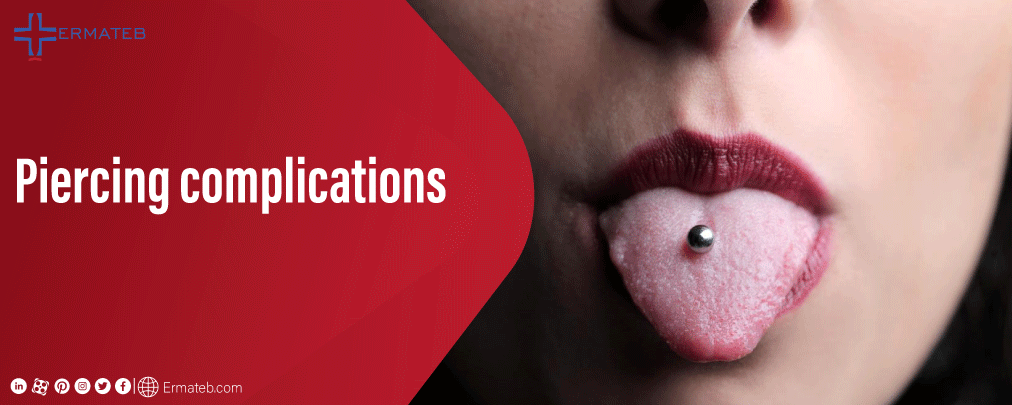
In recent years the prevalence of body piercing has increased so there are people who want to know the list of the documented risks and complications. Statistics show the increasing range of piercing among young social groups. Especially in developing countries range of piercing is up to 51% of the general population may have a piercing and the number ofi ndividuals with piercings continue to rise.Most of the complications are related to dermatologic risks like infection, hypertrophic scarring and keloid formation, and traumatic tearing. In this article, we tried to explain the most common complications which are possible to happen after having a piercing. These complications can be prevented with having special techniques.Although, the prevalence of body piercing has increased so has the list of recognized dermatologic risks and complications, some of which can lead to significant long-term cosmetic sequelae.
The most commonly reported adverse incident is about infectious of the piercing locations. There are combinations that lead the piercing locations to be infected including the trauma inherent, presence of a foreign body, and ...Any break in the integrity of your skin can expose you to the danger of local infections like cellulitis and abscesses as well as to systemic infections. However, the range of 10-30 percent of body piercings get localized infections, the rate of systemic infections is much less. Different factors affect the possibility of having infections like the anatomical positioning of the piercing, the experience level of the clinician, hygiene, aftercare, and the types of materials used (nickel alloys are among the most problematic with regardto an allergic reaction).
Among all types of piercings in various body locations, ear piercings are the type that is more often studied and reported. The rifest complication of ear piercings is an infection that occurs in up to 35 percentages of cases. Utilizing modern techniques for ear piercings has decreased the chance of getting infections with significant complications in the general population. The chance of infection is depending on the site of it on the ear. These percentages can be higher if the piercing is involving the cartilage. The cartilage type got increasingly popular among young generations in recent years. The cartilage type is also known as the high ear piercings. The available instructions suggest not having high ear piercings so this monitors the risk of infection. High ear piercings can lead the ear to get higher incidences of auricular perichondritis and abscess formation. Your anatomic variations like your blood supply to the site of the piercing can affect the possibility of infection. While Piercing sites in the earlobe heal for about six weeks, the cartilage and tragus piercings healing process can last for one year. Of the reported cases of infected cartilage in high ear piercing sites of the pinna, pseudomonas aeruginosa is the most commonly implicated, with staphylococcal and streptococcal infections were also reported. Cartilaginous infections are very hard to be resolved and due to this it's necessary to have aggressive therapy in the earlier course of the infection should be considered and empirical therapy of auricular chondritis must include broad-spectrum coverage (including antipseudomonal coverage), as an example with ciprofloxacin when oral antibiotics are appropriate. If the infection won't be monitored by conservative treatments, more aggressive treatments like surgical drainage and intravenous (IV) antibiotics should be considered. The healing process may cause permanent deformities such as 'cauliflower ear'.
Prevention is an important part in terms of piercing site infection and anatomic issues should be discussed with volunteers, as example patients must be made aware of the increased infectious risks associated with cartilaginous piercings. Also, only trained professionals who are more likely to be aware of and adhere to modifiable risk factors should perform ear piercings, and in particular high ear piercings. Piercing guns should be avoided, especially for cartilaginous piercings, as these are associated with an increased incidence of infectious problems like auricular perichondritis. This is thought to be related to additional blunt trauma and the associated shear forces deleterious to the perichondrium and the blood supply of the cartilage. Moreover, there is a documented seasonal element to infection risk and perichondritis is more common in the warm months of the year, when increased ambient temperature and skin moisture is thought to increase the proliferation of causative bacterial agents.
Treatment options have traditionally included intralesional steroid injections, cryotherapy, pressure dressings and bandages, radiation, laser therapy, surgical excision, or a combination of these various methods. Simple surgical excision is mostly followed by recurrence unless adjunct treatments are employed.
Allergic reactions. Some piercing jewelry — particularly pieces made of nickel — can cause allergic reactions
Oral complications
Skin infections
Other skin problems like hemorrhage in piercing sites
Bloodborne diseases
Tearing or trauma

